The first of the Yule Lads arrives tomorrow morning!
Stekkjarstaur, or Sheep-cote clod, visits the National Museum last year, to the delight of numerous children who generally regard the Yule Lads with a mixture of amusement and fear. Photo/ Mbl.is
The Icelandic Yule Lads, or jólasveinar as we call them in Icelandic are a bunch of strange characters who are either nine, or more popularly thirteen and are the sons of the trolls Grýla and Leppalúði. According to folklore they descend from the mountains one by one, starting with the first, Stekkjastaur, tomorrow morning.
Each of these strange, thieving men has a particular penchant of his own, including the love of sausages, skyr, candles and meat.
In later times, the Yule Lads began to bear a closer resemblance to Santa Claus, and Icelandic children place their shoe in the window every night from December 11th to December 23rd in the hope of receiving a small present. If a child has been naughty on a particular day, the Yule Lad in question simply leaves the unappealing option of a raw potato in their shoe. You may also spot a Yule Lad dressed exactly like Santa Claus, as these traditions have become rather merged.
The National Museum of Iceland in Reykjavik offers daily events celebrating the Yule Lads, an entertaining outing for young and old. According to the museum's website, most children would have wanted to avoid the Icelandic Yule Lads in the oldern days, since they were used by parents to frighten their children into behaving. "Evidently this was of some concern to Icelandic authorities, since in 1746 a public decree was issued to prohibit parents from frightening their children with monsters and fiends like the Yule Lads." The Yuletide Lads visit the museum daily at 11am from the 12th of December till 24th.
For the schedule of the National Museum's events click HERE.
Parents attempting this popular Icelandic Christmas tradition should note that the Yule Lads generally offer small presents such as sweets, gingerbread biscuits, tangerines, small toys and stickers or anything else they may have picked up on their journey from the mountains.
On the eve of December 24th however, after dinner, children and adults alike open their Christmas presents from each other after they've been placed underneath the Christmas tree.
Here is a translation of the well-known poem on the Yule Lads by Jóhannes úr Kötlum (1899- 1972) published on the museum's website. The translation into English is by Hallberg Hallmundsson. The costumes of the Yule Lads in the accompanying photos are the result of a joint effort by the museum and Icelandic designers to give them new clothes made from traditional Icelandic garb.
Sheep-Cote Clod
The first Yule Lad comes to town on 12 December. His name is Sheep-Cote Clod (Stekkjastaur) and he used to try to suckle the yews in the farmers' sheep sheds.
The first of them was Sheep-Cote Clod.
He came stiff as wood,
to prey upon the farmer's sheep
as far as he could.He wished to suck the ewes,
but it was no accident
he couldn't; he had stiff knees
- not to convenient.
Gully Gawk
On 13 December it is Gully Gawk's turn (Giljagaur). Before milking machines were invented he had a habit of stealing into the cowshed and slurping the foam off the milk in the buckets.
The second was Gully Gawk,
gray his head and mien.
He snuck into the cow barn
from his craggy ravine.Hiding in the stalls,
he would steal the milk, while
the milkmaid gave the cowherd
a meaningful smile.
Stubby
The Yule Lad who arrives on 14 December is called Stubby (Stúfur). He is a little, shall we say, vertically challenged. He is also known as Pan Scraper because in the old days he used to try snatching bits of food from the frying pan.
Stubby was the third called,
a stunted little man,
who watched for every chance
to whisk off a pan.And scurrying away with it,
he scraped off the bits
that stuck to the bottom
and brims - his favorites.
Spoon Licker
Spoon Licker (Þvörusleikir) comes down from the mountains on 15 December. In the past he would sneak into the houses and lick the wooden spoon used to scrape the pots. These days he looks for wooden spoons at the National Museum when he visits.
The fourth was Spoon Licker;
like spindle he was thin.
He felt himself in clover
when the cook wasn't in.Then stepping up, he grappled
the stirring spoon with glee,
holding it with both hands
for it was slippery.
Pot Scraper
Pot Scraper (Pottaskefill) is expected on 16 December. He is also sometimes called Pot Licker since in the old days he waited to snatch away the pots that had not been washed and licked the food remains from the insides.
Pot Scraper, the fifth one,
was a funny sort of chap.
When kids were given scrapings,
he'd come to the door and tap.And they would rush to see
if there really was a guest.
Then he hurried to the pot
and had a scrapingfest.
Bowl Licker
Bowl Licker (Askasleikir) comes to town on 17 December. In the past, Icelanders ate from lidded wooden bowls that they sometimes kept under the bed or on the floor. Bowl Licker would hide under the bed, and if someone put their bowl on the floor he grabbed it and licked the inside clean.
Bowl Licker, the sixth one,
was shockingly ill bred.
From underneath the bedsteads
he stuck his ugly head.And when the bowls were left
to be licked by dog or cat,
he snatched them for himself
- he was sure good at that!
Door Slammer
Door Slammer (Hurðaskellir) comes to town on 18 December. He always made a lot of noise when he walked around, slamming doors and such, so people could hardly get any rest. He still has a habit of slamming doors and always does when he visits the National Museum.
The seventh was Door Slammer,
a sorry, vulgar chap:
When people in the twilight
would take a little nap,he was happy as a lark
with the havoc he could wreak,
slamming doors and hearing
the hinges on them squeak.
Skyr Gobbler
On 19 December we welcome the Yule Lad called Skyr Gobbler (Skyrgámur). His favourite is an Icelandic dairy product called skyr, which is similar to yogurt. He likes it so much that he used to sneak into the pantry and gobble all the skyr out of the skyr tub.
Skyr Gobbler, the eighth,
was an awful stupid bloke.
He lambasted the skyr tub
till the lid on it broke.Then he stood there gobbling
- his greed was well known -
until, about to burst,
he would bleat, howl and groan.
Sausage Swiper
On 20 December we are expecting Sausage Swiper (Bjúgnakrækir). He loved to eat sausages and stole them whenever he had a chance.
The ninth was Sausage Swiper,
a shifty pilferer.
He climbed up to the rafters
and raided food from there.Sitting on a crossbeam
in soot and in smoke,
he fed himself on sausage
fit for gentlefolk.
Window Peeper
December 21 is when Window Peeper (Gluggagægir) visits. This Lad was not as greedy as some of his brothers, he just liked to peep through the windows and sometimes nicked the toys that he saw.
The tenth was Window Peeper,
a weird little twit,
who stepped up to the window
and stole a peek through it.And whatever was inside
to which his eye was drawn,
he most likely attempted
to take later on.
Door Sniffer
Door Sniffer (Gáttaþefur) comes to town on 22 December. He is easily recognised by his huge nose. He loved the smell of cakes and lace bread – sometimes called leaf bread – when they were being prepared for Christmas, and always tried to steal one or two.
Eleventh was Door Sniffer,
a doltish lad and gross.
He never got a cold, yet had
a huge, sensitive nose.He caught the scent of lace bread
while leagues away still
and ran toward it weightless
as wind over dale and hill.
Meat Hook
St. Thorlák's Day, 23 December, is the day of Meat Hook's arrival. Meat Hook (Kjötkrókur) was crazy about meat. In the old days he would lower a long stick through the chimney and snag a smoked leg of lamb hanging from the rafters, or a piece of smoked lamb from the pot. In those days the smoked lamb, which is traditional Icelandic Christmas fare, was cooked on St. Thorlák's Day.
Meat Hook, the twelfth one,
his talent would display
as soon as he arrived
on Saint Thorlak's Day.He snagged himself a morsel
of meet of any sort,
although his hook at times was
a tiny bit short.
Candle Beggar
Candle Beggar (Kertasníkir) arrives on Christmas Eve Day, 24 December. In former times, candles were the brightest lights available to people. They were so rare and precious that all children longed to have their very own candle for Christmas. And poor Candle Beggar – well, he also longed for a candle. The National Museum is open between 11 and 12 on Christmas Eve Day, to welcome Candle Beggar.
The thirteenth was Candle Beggar
- ‘twas cold, I believe,
if he was not the last
of the lot on Christmas Eve.He trailed after the little ones
who, like happy sprites,
ran about the farm with
their fine tallow lights.
From the poem The Yuletide Lads by Jóhannes úr Kötlum. English translation by Hallberg Hallmundsson.



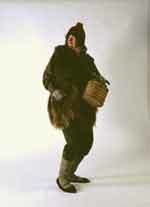
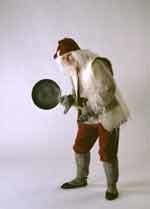
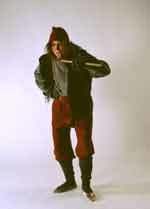
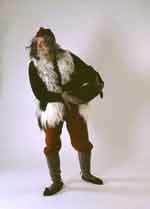
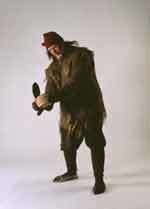
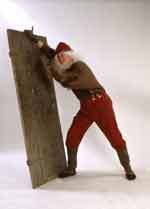
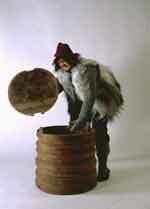
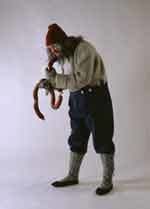
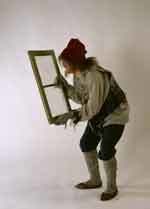
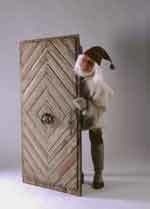
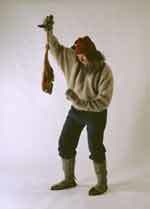


/frimg/1/57/94/1579405.jpg)
/frimg/1/57/87/1578747.jpg)



